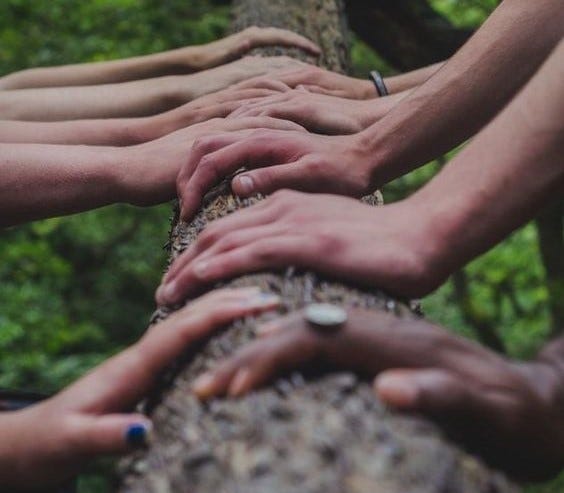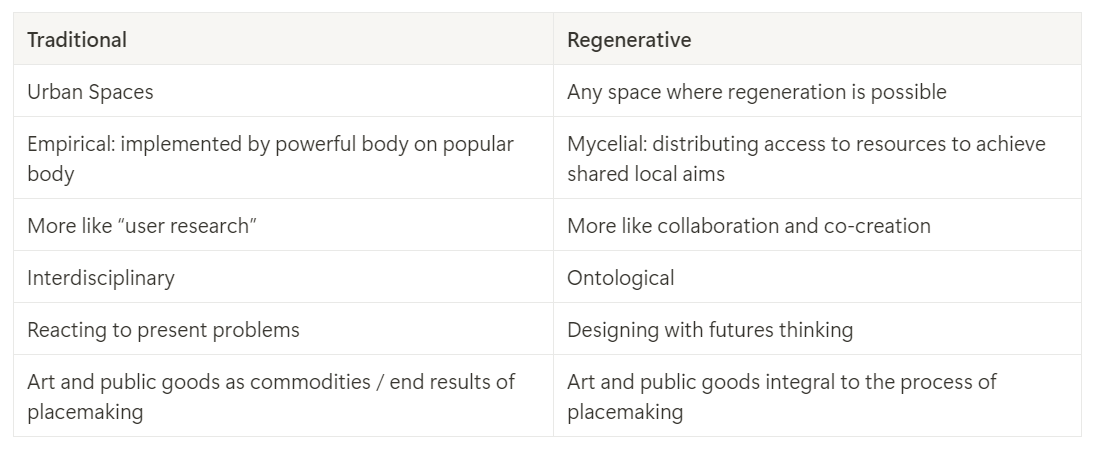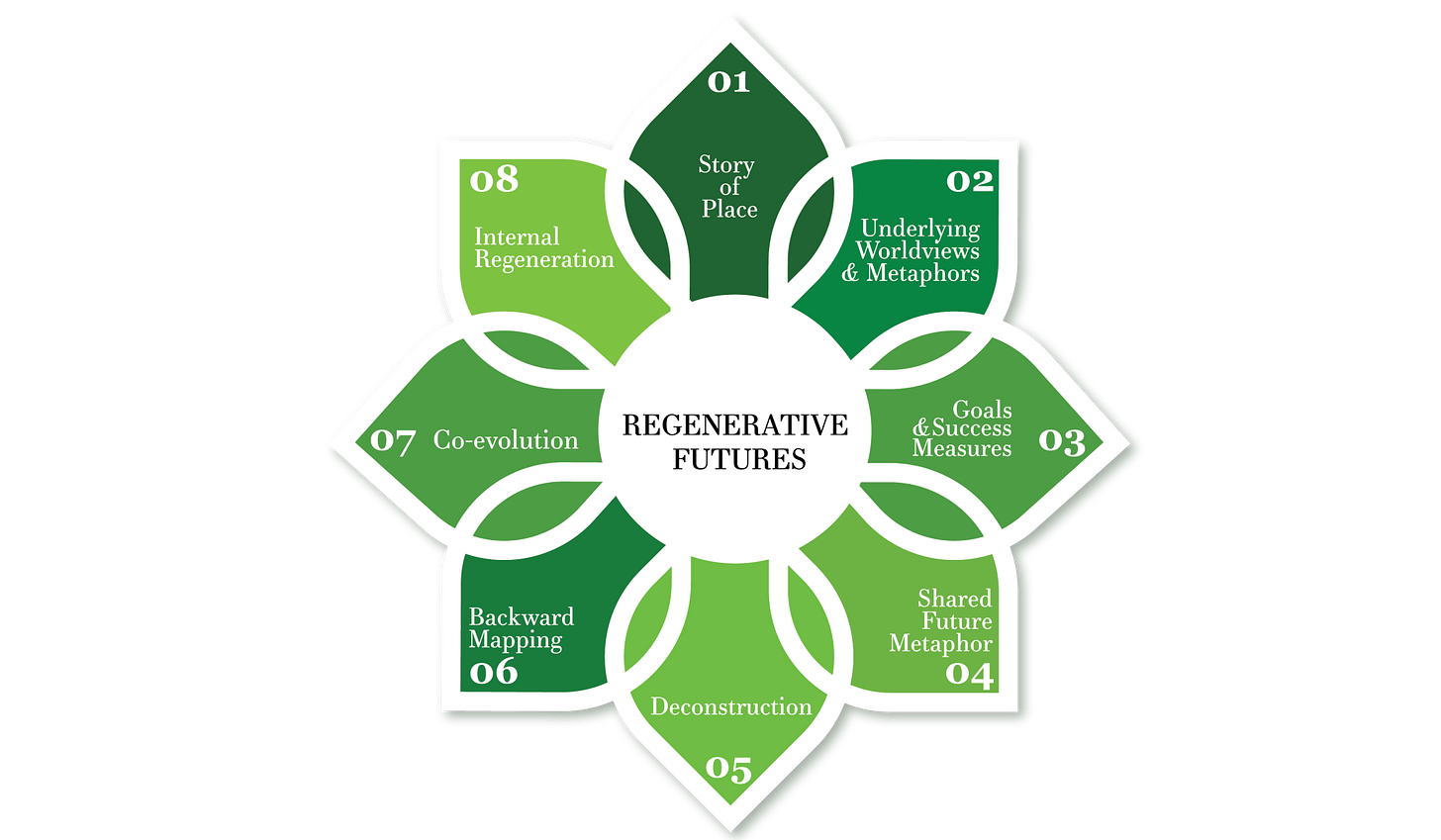The Untouchable Gardens We Seek
Many of my friends are world hoppers.
Going over plans for the rest of the year with them post-Burning Man went something like "San Francisco, Berlin, then Poland, Singapore, maybe Indonesia, then Thailand. How about you?”
I’m standing there, tired in my soul, and I say “I’m just really excited to finally land in my community in San Diego, and once I get there I probably won’t want to leave”.
Fact: I belong to a hypernomadic generation. We need placemaking now more than ever.
Frequent relocations due to job changes, housing costs, or lifestyle choices is completely normalized. Many friends permanently travel because it’s cool. We may argue that we are returning to the way humans use to roam — without borders — but traditional nomadic groups would move with the ecological cycles. We don’t.
We move with our whims, or according to international event schedules. We’ve forgotten what home feels like, except in the warmth of people we crisscross paths with on the conference circuit.
In my world, placemaking excavates the treasured lost feeling of home.
It settles us in to the places where we tend our untouchable gardens. It is how we weave meaning between ourselves in order to harness our collective inspiration and potential to create something we might dare to call “community”.
Let’s define regenerative placemaking, then explore the tools available to us to practice it.
What is (Regenerative) Placemaking?
We all want to live in thriving communities. Placemaking is a set of community engagement processes to design public spaces that improve social vitality and enhance quality of life.
The result? Spaces that foster social interaction, well-being, and a strong sense of place.
If you are placemaking, follow these principles:
Community Engagement — Involve local residents and stakeholders in the creation and ongoing evolution of their environment to ensure that spaces meet their needs and aspirations. Observe how people currently use and interact with spaces to gain insights into what works and what doesn’t.
Place Identity — Develop a unique character for each space that reflects its cultural, historical, and social context, making it meaningful and distinctive.
Functionality and Vitality — Design spaces that are not only aesthetic, but also functional, to promote active use and create hubs of interaction. For this, you need multiple design perspectives.
Inclusivity and Accessibility — Curate environments that are welcoming and accessible to all people, regardless of age, ability, or background.
Sustainability — Incorporate principles of environmental stewardship and sustainability to ensure that spaces are resilient and supportive of long-term ecological health.
Placemaking involves a commitment to iterative improvement and feedback. By continuously engaging with community members and responding to their experiences, it creates spaces that remain relevant and supportive over time.
There is also a primacy of process over outcomes. Placemaking emphasizes the effect that the process has on its participants over the need to force a solution or outcome that is premature or a poor fit.
Instead of imposing a design or structure onto the land, placemaking begins by listening to and understanding the intrinsic character and history of the place.
What Makes it “Regenerative”?
Regenerative placemaking comes with the additional lenses and frameworks of regeneration.

According to Bill Reed (LEED and Regenesis Group) Regenerative Development aims to work with the natural systems and ecological context of a place to co-evolve in ways that enhance the overall health of the community and environment over time.
Creative Placemaking combines arts and culture with community planning and development to strengthen a community's social, cultural, and economic fabric. These in combination create regenerative placemaking.
Here are some differences between “traditional” placemaking and regenerative placemaking, according to me.
The very first principle in The 8 Principles of Regenerative Design Thinking is “Story of Place”, which refers to the unique ecological, cultural, historical, and social narratives that define a specific location. Our task is understanding the deep, interconnected layers of a place—its landscape, its people, its past, and its potential future.
Every place has a unique identity shaped by natural and human systems over time. Kimberly Camrass PhD writes that “story of place considers nested human and natural systems and incorporates a layered understanding of reality and time”.
Story of place pays attention to:
Underlying worldviews and metaphors
The historical, cultural, and environmental factors that shape a community
Redress of previously accumulated “ecological debt”
In regenerative placemaking, the Story of Place is foundational. This concept promotes development that honors the land's ecological systems and cultural heritage while envisioning a future that supports resilience and regeneration.
As you’ll note, principles 4 and 6 of Regenerative Futures are “Shared Future Mapping” and “Backward Mapping”. Part of placemaking is understanding history, then writing it.
Roman Krznaric’s The Good Ancestor: How to Think Long Term in a Short-Term World, is a brilliant book that examines many influences and strategies for how to learn from the past and ensure a good future for the unborn.
A good mantra for placemaking is “honor the past and respond to the present”.
Place Identity and Place Politics
Modern cities/communities are often built for efficiency and consumption rather than fostering deep connections to the land or each other.
Buildings lack character, the public art is imported rather than locally inspired, and plazas are built with no attention to how citizens actually want to use that area.
This causes a profound disconnection, a "lack of anchoring" that leaves communities feeling transient. The result is shallow engagement with place.
Placemaking has the power to address this alienation.
Regenerative placemaking senses into and builds an identity of place using regenerative frameworks to actively sense into the layers of history, culture, and ecology that shape an area's identity. This practice builds an authentic identity of place—one that honors the land’s past, responds to its present, and nurtures its future.
A frequent tension arises when those who feel a deep connection to a place find themselves lacking agency to influence its direction. This tug-of-war between individual and place identity can be intensified when multiple narratives compete for the same space.
For example, some well-meaning ecovillages face accusations of neocolonialism because they see the earth as a shared home, but the members are perceived by locals as rich tourists from afar that change the social fabric of the place.
When placemaking, we are also engaging in the political work of harmonizing competing visions of place.
Making Your Place
There is identity of place, and there is the identity of you in that place.
Identity of Place — Familiarize yourself with the cultural heritage of the place. What traditions, lore, and landmarks does the place have? The character of a place may change over time, but its history doesn’t.
Identity of You in that Place — Find your niche in the local ecosystem. What is the story that led you to this place? What are your connections to it? Your community could always benefit from your unique fingerprint.
Just as much as placemaking is an empirical design practice that adds intentionality to a community, it is a personal practice. It invites you as the individual to root into, discover, and co-create the essence of whichever community you find yourself in.
As a community builder, you placemake to bring more sense to your community.
As a community member, you placemake to bring community closer to your senses.
We have an experiential, sensory connection with our environments. At its core, placemaking is about forming a relationship with your environment so rich and grounded that it becomes a part of you.

I invite you to make observations about your environment today using your senses. What does this sensory information tell you about the identity of this place? How can you use this information to understand your role in this space?
As we move forward, the challenge is to reconnect with the spaces we inhabit, grounding ourselves not in fleeting moments but in the lasting presence of community. It's time to rediscover the untouchable gardens of our lives and invest in building the places that anchor us.









Yup. Would travel nomadic with the ecological cycles. Now it's whim & conference circuit. Imo just listen to the free replay, no need to go to Stinkapore for Balaji & Vitalik - I'm based (stuck) in Singapore & wouldn't even pay for that 😂🤣 find a good developer/programmer to build what I want instead of calling freeloading 'co-creating' (as is so common in 'transformational culture' is more worth the money, imo. Rather than hype & weird overwrought theories.
Nicole, your article came at the perfect time for me! We are just at the beginning of creating our coliving community space, and it’s fascinating to see how certain places can leave such an imprint on us, making departures feel very different.
I’ve just left my own coliving community, and reading your reflections on placemaking and the deep connection we form with spaces really touched me. Your words helped me understand why this departure felt so different. You captured the essence of what it means to ground ourselves in a place, to understand where we fit in its history, and how we can shape its future while striving to be a "good ancestor."
In my own journey, I’ve been reflecting on how certain spaces don’t just hold our memories but grow and evolve with us—and even without us. Your insights helped me connect the dots between the sense of grounding I’ve been feeling and the legacy we leave in the places that welcome us.
I recently wrote about my experience of leaving a place that became much more important to me than I ever imagined: https://maysou.substack.com/p/a-noste-week-65
Thank you for sparking such meaningful reflections!